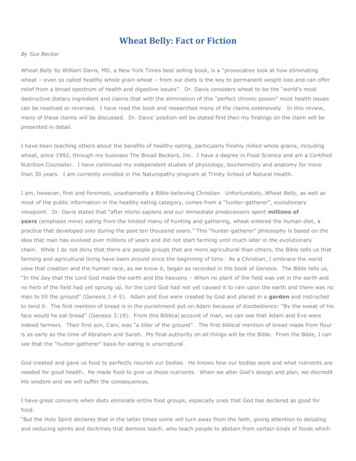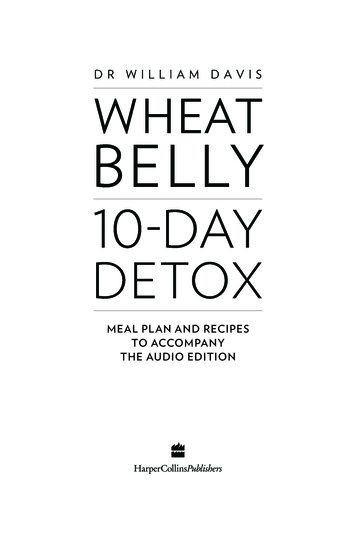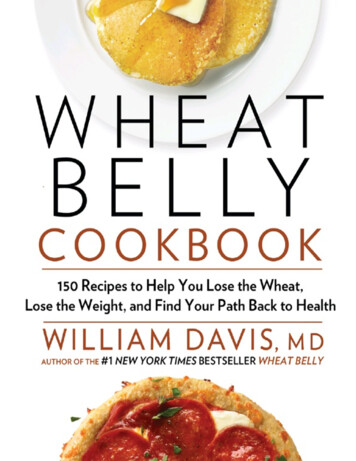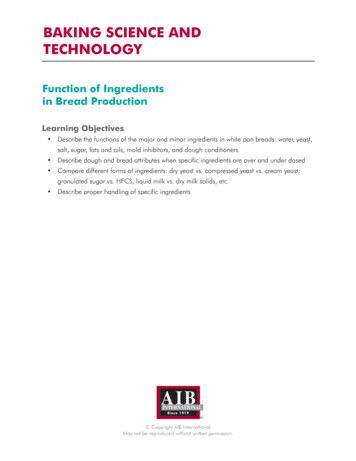
Transcription
Wheat Belly: Fact or FictionBy Sue BeckerWheat Belly by William Davis, MD, a New York Times best selling book, is a “provocative look at how eliminatingwheat – even so called healthy whole grain wheat – from our diets is the key to permanent weight loss and can offerrelief from a broad spectrum of health and digestive issues”. Dr. Davis considers wheat to be the “world’s mostdestructive dietary ingredient and claims that with the elimination of this “perfect chronic poison” most health issuescan be resolved or reversed. I have read the book and researched many of the claims extensively. In this review,many of these claims will be discussed. Dr. Davis’ position will be stated first then my findings on the claim will bepresented in detail.I have been teaching others about the benefits of healthy eating, particularly freshly milled whole grains, includingwheat, since 1992, through my business The Bread Beckers, Inc. I have a degree in Food Science and am a CertifiedNutrition Counselor. I have continued my independent studies of physiology, biochemistry and anatomy for morethan 30 years. I am currently enrolled in the Naturopathy program at Trinity School of Natural Health.I am, however, first and foremost, unashamedly a Bible-believing Christian. Unfortunately, Wheat Belly, as well asmost of the public information in the healthy eating category, comes from a “hunter-gatherer”, evolutionaryviewpoint. Dr. Davis states that “after Homo sapiens and our immediate predecessors spent millions ofyears (emphasis mine) eating from the limited menu of hunting and gathering, wheat entered the human diet, apractice that developed only during the past ten thousand years.” This “hunter-gatherer” philosophy is based on theidea that man has evolved over millions of years and did not start farming until much later in the evolutionarychain. While I do not deny that there are people groups that are more agricultural than others, the Bible tells us thatfarming and agricultural living have been around since the beginning of time. As a Christian, I embrace the worldview that creation and the human race, as we know it, began as recorded in the book of Genesis. The Bible tells us,“In the day that the Lord God made the earth and the heavens – When no plant of the field was yet in the earth andno herb of the field had yet sprung up, for the Lord God had not yet caused it to rain upon the earth and there was noman to till the ground” (Genesis 1:4-5). Adam and Eve were created by God and placed in a garden and instructedto tend it. The first mention of bread is in the punishment put on Adam because of disobedience: “By the sweat of hisface would he eat bread” (Genesis 3:19). From this Biblical account of man, we can see that Adam and Eve wereindeed farmers. Their first son, Cain, was “a tiller of the ground”. The first biblical mention of bread made from flouris as early as the time of Abraham and Sarah. My final authority on all things will be the Bible. From the Bible, I cansee that the “hunter-gatherer” basis for eating is unscriptural.God created and gave us food to perfectly nourish our bodies. He knows how our bodies work and what nutrients areneeded for good health. He made food to give us those nutrients. When we alter God’s design and plan, we discreditHis wisdom and we will suffer the consequences.I have great concerns when diets eliminate entire food groups, especially ones that God has declared as good forfood.“But the Holy Spirit declares that in the latter times some will turn away from the faith, giving attention to deludingand seducing spirits and doctrines that demons teach who teach people to abstain from certain kinds of foods which
God created to be received with thanksgiving by those who believe and have an increasingly clear knowledge of thetruth.” I Timothy 4:1,3 (AMP version)Page after page of the Wheat Belly book is filled with arguments against wheat. Much of the substantiating evidenceagainst wheat is based on the detrimental affect wheat has on people with celiac disease. One would certainly expectdetrimental health responses to wheat for a celiac person. Celiac disease is caused by an inability to digest aparticular protein component of gluten, known as gliadin. Gluten is the naturally occurring protein of most grains,particularly wheat. If you can not properly digest a food, then it is toxic to you. It is not surprising then that peoplewith celiac disease will have health issues if they do not eliminate gluten from their diets and will certainly feelremarkably better when they do. The diet recommended in Wheat Belly is basically a high protein, low carbohydratediet, with the elimination of ALL grains, not just wheat.We need to be cautious about the elimination of entire food groups, especially when the recommendations are basedon how that food group affects a particularly small representation of people. For example, Phenylketenuria is a raredisease in which a person is born lacking the enzyme to digest the amino acid, phenylalanine. Phenylalanine is anaturally occurring amino acid found in most protein rich foods such as meats, eggs and milk. Babies are tested forthis disease at birth (PKU), and if found to have it are placed on a very low protein diet. Those people who do notadhere to the diet suffer many serious health issues including mental retardation. The high protein diet recommendedby Dr. Davis would be debilitating for someone with phenylyketonuria, causing many health issues, just as glutendoes for a celiac. Yet, Dr. Davis does not think meat is a poison, but it certainly is to a phenylketonuria patient. If webased our opinions on how meat affects someone with phenylketonuria, we would conclude that meat, eggs, and milkare very dangerous foods, because they contain phenylalanine. Phenylketonuria is indeed less common than celiacdisease, but celiac disease affects less than 1% of Americans.In the remainder of this study, you will find only a few of my own findings when I began to research some of the“facts” presented in the Wheat Belly book. Dr. Davis’ viewpoints will be presented first, in bold type, and are eitherdirect quotes or implications from statements made in the book. My analysis will follow. Dr. Davis mingles the terms “genetic modification”, “hybridization”, and “human modification”throughout his discussion of modern wheat.The use of these terms interchangeably throughout the same discussion, sentence or paragraph is confusing andmisleading to the reader. Though never stated directly, it is certainly implied that the modern dwarf wheat is theresult of genetic modification. Dr. Davis also uses examples of other truly genetically modified foods, such assoybeans, as examples for his arguments against wheat. This is deception at its best, causing the reader to drawwrong conclusions.Despite the implication in the book, the modern dwarf wheat is NOT a result of genetic modification but of traditionalplant breeding techniques. The modern dwarf wheat was developed by cross breeding thousands of strains of wheatto produce a seed with higher crop yield and finally crossing the variety with Japanese dwarf wheat. This produced ashorter plant that would not bend under the heavier heads of grain. The cross breeding was done wheat-to-wheat,unlike genetic modification that crosses genes from other species with wheat. Wheat has NOT been approved forgenetic modification in the US. There is NO genetically modified commercially grown wheat in the US.
For the record, I am totally against the use of genetic modification in our food.It is important for us all to realize that the US is the largest exporter of wheat in the world. Mexico and Japan are ourlargest importers. There is widespread global resistance to genetically modified grains. Other countries won’t importgenetically modified wheat. Wheat farmers in this country have resisted the development of genetically modifiedwheat and, in 2005, a trial project was dropped and government approval was never requested. The last trials weresupposedly done in 2001, however, I have been told that trials are being done in ND and HI. The recent finding ofgenetically modified wheat in Oregon actually has wheat growers outraged. They do not want their cropscontaminated anymore than we do.I want to encourage readers everywhere to be informed. Dig deeper than the popular publications, as the informationcited can often be traced back to only one source. Do not be deceived. Look for facts. Seek wisdom from God andHis word. Fear is a tool of the enemy, not of God.For clarification, let me just state again that wheat has NOT been approved for genetic modification in the US. Thereis no GMO wheat grown commercially in the US.Finally, organic by definition cannot be genetically modified, so when in doubt, buy organic. Dr. Davis claims that “wheat has been modified by humans to such a degree that modern strains areunable to survive in the wild without human support ”. (page 22)Again, the use of the term “modified” can be misleading. Though the statement does not say it, most concernedreaders might interpret that statement to mean genetically modified.To obtain higher yields, the dwarf wheat may indeed require heavier nitrogen fertilization, but without the fertilization,the crop will most definitely survive and yield an adequate crop. In fact, the dwarf wheat was developed to direct itsenergy to produce “fruit” instead of a large plant and to grow in areas with less desirable soil and growingconditions. Dr. Davis actually contradicts himself a few pages later by stating that “short stalks reach maturity morequickly, which means a shorter growing season with less fertilizer required to generate the otherwise useless stalk.”To say that modern wheat can not survive in the wild is nothing short of ridiculous. We are not talking about a wildanimal that has been domesticated and lost its natural survival instincts. We are talking about a plant that needswater, soil, and sunshine. The Bible tells us to “consider the lilies of the field and learn thoroughly how they grow,they neither toil nor spin.” Matthew 6:28 Dr. Davis implies that the modern dwarf wheat is some kind of reproducing machine gone bad, coiningsuch terms as “synthetic wheat” and claims that 5% of the proteins in the modern wheat is unique to thevariety meaning that they are found in neither parent.Let me just say emphatically, this is genetically impossible. Plants can only express proteins they have the geneticcode to produce. Certain conditions can affect the expression of these proteins but the plant cannot produce a proteinwhen the code for that protein is not there. To put it simply, in human terms, you can not have a blue eyed child ifthere is no gene for blue eyes. You may never have a blue eyed child even if the gene is there, but you absolutely
can not have one if there is no gene or code for it. I do not mean to oversimplify here, but genetics is genetics. Dr. Davis discusses how even freshly milled modern wheat caused adverse affects for him, comparinghis reactions to freshly milled einkorn with freshly milled organic hard red wheat in the section “A GoodGrain Gone Bad?”. (page 26-27)The reactions Dr. Davis mentions having to red wheat are very typical of some one that has a wheat sensitivity. Dr.Davis states that he indeed has a wheat sensitivity. It is a fact that people with wheat sensitivity can often bettertolerate the ancient grains such as Kamut khorasan wheat, einkorn, spelt, and emmer. But for the rest of the 90%of Americans who do not have a wheat sensitivity there should be no adverse reactions. Dr. Davis also admits thathis isolated reaction hardly constitutes a clinical trial. I completely agree. His personal experience is completelycontrary to what we have seen in thousands of customers, of more than 20 years, who start milling predominatelywheat. Dr. Davis makes continuous references to “healthy whole grains” claiming they are no healthier thanthe white flour counter parts. He claims that his patients feel better and lose weight when they give uptheir “healthy whole grain” waffles and bagels for breakfast and replace them with a 3 egg omelet.There is no such thing as “healthy whole grain” processed bread products in the regular grocery store. Between 1870and 1890, all commercial grain milling methods in the US were replaced by automated rolling mills. These rollingmills separate the bran and germ portions from the endosperm, or the white flour portion. White flour is basicallyprotein and starch. Most all of the vitamins, minerals, fatty acids, and fiber are located in the bran and germ. Theremoval of the bran and germ leaves the white flour virtually devoid of nutrients except of course for the protein andstarch.By 1910, the new white flour had taken over the market, making white flour and white bread food for themasses. Shortly thereafter, three vitamin deficiency diseases became epidemic. Enriching the flour was necessary toreplace the nutrients that were lost in the milling process. For the more than thirty nutrients lost with the removal ofthe bran and germ, only four were returned – three synthetically produced B vitamins and iron. A fifth nutrient, folicacid, was later added to enriched flour because of the rising incident of birth defects. Chlorine derived bleachingagents are also used making the flour whiter, as well as conditioners such as potassium bromate, that are certainlyunwelcome additions.Most people do not realize that ALL commercially milled flour in the US today is made on these huge rollermills. Commercially milled whole wheat flour is not at all the same as what you get if you milled the flouryourself. Even flour labeled whole grain is not what one may think.“During the milling process, steel rollers crush the grain, and the white flour released from the endosperm isseparated by sifters into different grades according to fineness. The protein portion of white flour is roughly 75%gluten. The bran and germ, which make up about 28% of the wheat kernel, are totally removed in commerciallymilled flour. Components may be recombined later to form a variety of flours to be sold for varying uses.” (NutritionalCharacteristics of Organic Freshly Milled Stone-Ground, Sourdough and Conventional Breads by Campbell, Hauser,and Hill, Ecological Agricultural Projects (EAP publication 35)
Whole Wheat Flour is produced commercially by recombining ground bran with the white flour. The wheat germand oil is left out, as it would cause the flour to go rancid quickly. No legal specifications are required for thislabeling. Most people think “whole wheat” means “whole grain”.Whole Grain is actually a legal term with specific content requirements for labeling. To “make” whole grain flour, thewhite flour must be recombined with the bran and germ according to legal specifications for flour to fiberratio. Gluten, the protein portion of white flour, can be completely extracted from the white flour. Even though whiteflour is predominately gluten and starch, the extracted gluten, however, is not considered “flour” by legalstandards. Gluten can therefore be added in abundance to flour products, even those labeled “whole grain”. Theaddition of extra gluten greatly alters the fiber to flour ratio of the “whole grain” product. This is an unnatural amountof gluten in these “healthy whole grain” products, the consumption of which will not give the desired health benefits, ifany at all. This isolated gluten is also found in many non bread products such as soy sauce and taco seasoning.It is important to mention here that gluten, as it naturally occurs in grains, is not a “bad guy” any more thancholesterol is a bad guy as it appears naturally in eggs and fats. In fact, gluten, as it occurs naturally in most grains,contributes several valuable amino acids to our diets. Amino acids are the building blocks of all protein. Protein foodsare important as they supply the body with the necessary amino acids for strength and good health. Glutamine is justone such amino acid. It is known to promote gut health and brain function. The richest food source of glutamine iswheat gluten. Wheat is considered a good protein source for adults as it supplies significant amounts of all essentialamino acids, except lysine. The addition of legumes, meat, or milk will supply the needed lysine, making wheat acomplete protein source even for growing children.So, there is simply no comparison between a breakfast of store bought waffles or bagels, which are not healthy nomatter what they are labeled, and a breakfast of a three egg omelet and cheese. Of course you feel more sustainedon the omelet, but a breakfast of freshly milled whole grain waffles will stabilize your blood sugar and satisfy yourhunger for hours, giving you lots of energy. People have different body chemistry. Some people do better on morecarbohydrates while others do better on more protein, but always the carbohydrates must be real – real fruits, realvegetables, and real whole grains.The invention of the steel roller mills in the late 1800s revolutionized the American diet. Some statistics show that areal decline in America’s health began around 1910. Over one hundred years of eating basically protein and starch,isolated from the rest of the many valuable nutrients found in wheat and all other grains, has contributed to many ofthe health issues we now see in this country. Dr. Davis makes a bold correlation between the rise of obesity and the increase in consumption ofwheat: “The sad truth is that the proliferation of wheat products in the American diet parallels theexpansion or our waist. Advice to cut fat and cholesterol intake and replace the calories with wholegrains that was issued by the National Heart, Lung, and Blood Institute through its National CholesterolEducation Program in 1985 coincides precisely with the start of a sharp upward climb in body weight formen and women. Ironically, 1985 also marks the year when the Centers for Disease Control andPrevention began tracking body weight statistics, tidily documenting the explosion in obesity anddiabetes that began that very year.” (Page 6)There is something simplistically wrong with this statement. If the Center for Disease Control only began tracking in
1985, how is it possible to know when the “explosion” in obesity started? What was happening before1985? Statistics I have read report the decline in America’s health beginning as early as 1920, with a drastic dropfrom 1978 to 1980. In 1978, America’s health was ranked 79 out of 100 countries studied. In 1980, the US haddropped to 95 out of 100. This was just in two short years and all prior to 1985.Could this rapid decline have started in the 1970s when the high protein/low carbohydrate diets were first introducedby Dr. Robert Atkins?Diets such as the Paleo Diet and the Wheat Belly diet are nothing more than the highprotein/low carb diet by a different name.The REAL truth, according to the USDA Economic Research Service, is that wheat consumption has actually DECLINEDin the past 100 years, while meat and sugar consumption have drastically increased.In 1829, wheat consumption averaged about 225 lbs/person/year. It dropped steadily to 180 lbs/person in 1925,bottoming out in 1972 to an all time low of 110 lbs/person/year. There was a slight increase up until 1997, but onlyup to 147 lbs/person/year. According to the USDA Economic Research Service, “the 10 year growth ended in 1997with the adoption of the low carbohydrate diets”, leading again to a decline in wheat consumption, rapid at first,reaching a low in 2005. In 2011, the estimated consumption of wheat is only 132.5 lbs/person/year. That is nearly100 lbs/person/year less than what it was 100 years ago.A striking change in wheat flour use occurred in the past century. At the turn of the 20th century, home bakingaccounted for 90 percent of total flour consumption, with commercial bakeries accounting for 10 percent. By 1945,the bakery portion rose to 60 percent as home baking dropped with the entry of women into the workforce. By 1990,less than 10 percent of flour was consumed in the home. As one can see, these facts do not coincide with thestatements presented in the Wheat Belly book, since wheat consumption has actually decreased while the obesity rateand waistlines have increased.Also interesting is the fact that by 1980, the dwarf wheat was accepted worldwide to prevent food shortages andhunger in other countries. If wheat is the problem, then why have China, Mexico, and many Third World countries,which all use the dwarf wheat variety, not seen the rise in obesity and decline in health like America?In the more than two decades I have been teaching others the health benefits of freshly milled whole grains, includingwheat, I have seen countless lives improved by weight loss. Dr. Davis’ claims about wheat, weight gain, andparticularly fat accumulation around the middle contradict many other studies conducted over the years. One suchstudy, the Framingham Heart Study found that those who ate at least 3 servings of whole grains everyday had theleast fat accumulation around the middle. Another 12 year study, conducted among women, to investigate therelationship between the intake of dietary fiber, whole grains, and weight gain over time, found that those whoconsumed the most whole grains weighed less than those who consumed less whole grains. Those with a high wholegrain intake had a 49% lower risk of major weight gain over time. Dr. Davis makes the claim that wheat is a major contributor to weight gain and that the singleelimination of wheat alone will promote weight loss. “If glucose-insulin-fat provocation from wheatconsumption is a major phenomenon underlying weight gain, then elimination of wheat from the dietshould reverse the phenomenon. And this is exactly what happens.” (Page36)
Dr. Davis states that “a Mayo Clinic/University study of 215 obese celiac patients showed 27.5 pounds ofweight loss in the first six months of a wheat free diet.” (Murray JA, Watson T, Clearman B, MitrosF. Effect of gluten-free diet on gastrointestinal symptoms in celiac disease. Am J Clin Nutri 2004 April)First of all, what does this statement even mean? Does he mean 27.5 pounds per person, total for the group, or is itan average?I found this study and read it for myself. It was not 215 obese celiac patients but simply 215 celiac patients. Ofthem, only 23% had Body Mass Index (BMI) 25 and only 11% of these had BMI 30. A BMI of 30 is consideredobese. If you do the math, that puts the obese number in this study at 5-6 patients, not all 215! Half of the patientshad a BMI 20. That means half of the 215 were normal or below normal weight. The conclusion of the study thenstates that the same proportion of males and females gained or lost weight after the institution of a gluten free diet(males – 31% gained, 41% lost, females – 36% gained and 35% lost). Ninety one patients gained (emphasis mine)weight between the time of diagnosis and 6 months after starting a gluten free diet. In the same period, 25 patientslost an average of 27.5 lbs. There is the 27.5 lbs Dr. Davis mentions, but it is an average among only 25patients. According to the conclusions of the study, “this weight loss was most pronounced in the patients who wereobese at diagnosis. However, 12 patients who had normal or low weight at diagnosis actually lost weight despite agluten-free diet. This was largely due to excessive food restriction rather than persistent disease.”These results are significantly different than the statements made by Dr. Davis in the text above. I am not sure whythe facts are misrepresented, but they certainly are. As you can see for yourself, these facts do not make a greatcase for gluten free and weight loss.In more than 20 years of hearing the testimonies of others, we have seen many people experience great weight loss ifneeded when they began to eat freshly milled whole grains, including wheat. They also saw improvements in theiroverall health, skin and hair. Dr. Davis makes claims about the affects of wheat on blood sugar and weight loss using the glycemicindex as evidence: “An interesting fact: Whole wheat bread (glycemic index 72) increases blood sugar asmuch as or more than table sugar, or sucrose (glycemic index 59). (Glucose increases blood sugar to 100,hence a glycemic index of 100. The extent to which a particular food increases blood sugar relative toglucose determines that food’s glycemic index.) So when I was devising a strategy to help myoverweight, diabetes-prone patients reduce blood sugar most efficiently, it made sense to me that thequickest and simplest way to get results would be to eliminate the foods that caused their blood sugar torise most profoundly: in other words, not sugar, but wheat.” (page 8-9)The glycemic index was devised to classify carbohydrate food according to their potential to raise your blood sugarlevel. Let me first reiterate the fact that commercially milled whole wheat flour does NOT contain the entirecomponents of the wheat kernel. The wheat bran is partially removed and the wheat germ and oil are completelyremoved. With the bran and germ’s removal a valuable portion of fiber is lost. Fiber has been proven to slow theabsorption of sugars released from carbohydrate digestion. But let’s look at the glycemic index charts for ourselves:Glycemic Index (GI)
White wheat flour bread – GI 71Wonder BreadTM , average – GI 73Whole Wheat bread, average – GI 71 (referring to store-bought “whole wheat bread)These numbers certainly seem to confirm the above Wheat Belly statements. But continue looking and you will findsome interesting numbers that Dr. Davis fails to mention:50% cracked wheat kernel bread – GI 58100% Whole GrainTM bread (Natural Ovens)* - GI 58*Natural Ovens is a locally owned bakery in Manitowac, Wisconsin that makes their bread from whole grain flour withadded flaxseed meal.Last but not least:Whole wheat kernels (the whole grain itself) – GI 30If real wheat is the problem, then why these low glycemic numbers and why did Dr. Davis leave them out of the book!Let me reiterate the fact that there is no such thing as healthy whole grains in the regular grocery store. The onlyway to get real whole grain bread and bread products is to make them yourself from flour that you have milled foryourself or from a reputable bakery (e.g. -www.realbreadcompany) that mills their own flour and adds no whiteflour to their products. Any commercially made product is made from flour that has been processed and sifted. Dr. Davis claims that wheat is, in effect, an appetite stimulant. Accordingly, people who eliminatewheat from their diet consume fewer calories The elimination of the heavily processed flour products alone, consumed by most Americans, will result in fewercalories for sure but will leave most people craving these sugar filled, nutrient devoid delicacies. However, our bodiesuse carbohydrates for energy and brain function. So if you replace those sugar filled high calorie foods with realwhole grains, you will be satisfied and have much sustained energy. What we have seen over the past 21 years, inourselves and countless others who consume their own freshly milled whole grain flour from the entire kernel of wholegrain, including wheat, is that sugar and simple carbohydrate cravings virtually disappear and appetites arecompletely satisfied. The fiber found in whole grains fills you up. The number of calories consumed is reduced andhunger is completely satisfied.“Jesus replied, ‘I am the Bread of Life. He who comes to Me will never be hungry ’” John 6:35. Dr. Davis makes very alarming attacks on wheat in the section entitled, “Whole Grain Brain”. He says,“The effect of wheat on the brain is more than just influence over mood, energy, and sleep. Actual braindamage is possible ”“In one particularly disturbing Mayo Clinic study of thirteen patients with recent diagnosis of celiacdisease, dementia was also diagnosed.” “Of the thirteen, nine died due to progressive impairment of brainfunction. Yes: fatal dementia from wheat.” (page 172-173)This is sensationalism used to the extreme! In the study cited, the Mayo Clinic searched medical records for morethan 30 years to find patients who showed both celiac disease and dementia. Only 13 were found that met the
criteria. Let me say that again – 13 from over 30 years of medical records at a major medical clinic! In the study, itis not clearly stated whether a gluten free diet is followed by all the patients studied. It mentions that several of thepatients improved as long as the gluten free diet was implemented. Does this mean that the nine patients that Dr.Davis states “deteriorated and died”, followed a gluten free diet as well? It is not clear. If so, then the diet did nothelp. If not, then it is only logical that a celiac patient will deteriorate in any aspect if gluten is not eliminated becausegluten cannot be digested by someone with celiac disease. Any food that can not be digested properly is a toxin tothat person. But we do not all have celiac disease. In fact, celiac disease affects less that 1% of Americans.Dr. Davis speaks of the fact that gluten when broken down into its polypeptides can cross the blood-brain barrier likeit is a bad thing, even likening it to drug addiction because it can “induce a form of reward, a mild euphoria”. I findthis section of the book particularly interesting. In my recent studies for my certification in nutrition counseling, Iread some intriguing facts when studying particular amino acids: Donald Lepore, N.D in The Ultimate Healing System states that: “Glutamic acid is a nonessential amino acid (can beconstructed within the body). About 90% of the dry weight of the brain consists of protein. Approximately half of theamino acid composition in the brain is represented by glutamic acid and its derivatives, which incl
Wheat Belly: Fact or Fiction By Sue Becker Wheat Belly by William Davis, MD, a New York Times best selling book, is a "provocative look at how eliminating wheat - even so called healthy whole grain wheat - from our diets is the key to permanent weight loss and can offer relief from a broad spectrum of health and digestive issues". Dr.










